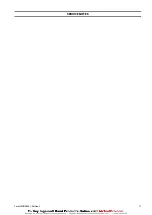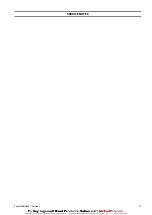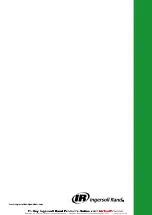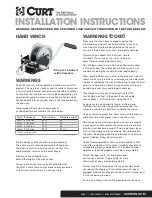
Setting with test load:
Actuate auxiliary valve to TENSIONING position. Winch should operate, causing load
line to become taut. To increase tension, rotate regulator knob
clockwise
until load
begins to rise. Rotate regulator knob
counterclockwise
a minimum of 1/4 turn, or until
load is balanced (does not raise or lower). Note pressure indicated on gauge for
future setting reference.
Setting with scale:
Actuate auxiliary valve to TENSIONING position. Winch should operate, causing load
line to become taut. To increase tension, rotate regulator knob
clockwise
until scale
indicates desired tension. Note pressure indicated on gauge for future setting
reference.
n
Disassembly
n
General Disassembly Instructions
The following instructions provide necessary information to disassemble, inspect,
repair, and assemble product. Parts drawings are provided in Product Parts
Information Manual.
If a product is being completely disassembled for any reason, follow the order of
topics as they are presented. It is recommended that all maintenance work on
product be performed in a clean dust-free work area.
In the process of disassembling product, observe the following:
1. Never disassemble product any further than is necessary to accomplish needed
repair. A good part can be damaged during the course of disassembly.
2. Never use excessive force when removing parts. Tapping gently around
perimeter of a cover or housing with a soft hammer, for example, is sufficient to
break the seal.
3. Do not heat a part with a flame to free it for removal, unless part being heated
is already worn or damaged beyond repair and no additional damage will occur
to other parts.
In general, products are designed to permit easy disassembly and assembly. The
use of heat or excessive force should not be required.
4. Keep work area as clean as practical, to prevent dirt and other foreign matter
from getting into bearings or other moving parts.
5. All seals, gaskets and ‘O’ rings should be discarded once they have been
removed. New seals and ‘O’ rings should be used when assembling product.
6. When grasping a part in a vise, always use leather-covered or copper-covered
vise jaws to protect the surface of part and help prevent distortion. This is
particularly true of threaded members, machined surfaces and housings.
7. Do not remove any part which is a press fit in or on a subassembly unless removal
of that part is necessary for repairs or replacement.
8. When removing ball bearings from shafts, it is best to use a bearing puller. When
removing bearings from housings, drive out bearing with a sleeve slightly
smaller than outside diameter of bearing. The end of sleeve or pipe which
contacts bearing must be square. Protect bearings from dirt by keeping them
wrapped in clean cloths.
n
Winch Disassembly
NOTICE
•
Remove band brake if equipped. Refer to
‘Manual Band Brake (optional feature)’ on page 7 and
‘Automatic Band Brake (optional feature)’ on page 7 for specific
instructions.
Refer to Dwgs. MHP0875, MHP1007, MHP2944 and MHP2948.
1. Remove wire rope from drum.
2. Operate winch to position reduction gear drain plug at its lowest position.
3. Relieve pressure in air lines by operating winch control several times after air
supply has been turned off.
WARNING
•
Shut off, bleed down and disconnect air supply line before performing any
disassembly procedures.
•
The weight of a winch with a 24 inch (610 mm) long drum and no wire rope
is 3550 lb. (1610 kg). Exercise caution when lifting and moving winch.
4. Disconnect and tag air lines.
5. Remove winch from its mounting and take to a suitable work area before
beginning disassembly.
6. Remove lower case pipe plug (218) on motor housing (217) and allow oil to drain
into a suitable container and dispose of in an environmentally safe manner.
Loosen vent cap (210) to vent motor housing.
7. Drain oil from reduction gear assembly by removing one plug (406) when
positioned at its lowest point and one plug (406) from its highest point to vent.
Refer to Dwg. MHP0567 in Product Information Manual. If winch is equipped
with a band brake, elevate the winch outboard end (opposite from motor end)
to prevent draining oil from contaminating brake band lining.
8. For winches with a disc brake, remove pipe plug (24) in brake housing (21) to
drain brake oil.
9. Remove band brake, winch guard and any other externally mounted winch
attachments.
10. Refer to ‘Winch Guard Disassembly’ on page 8.
a. Remove panels (805) and (807), one section at a time, by removing locknuts
(804) and crossbars (806).
b. Remove capscrews (197) and washers (117) securing lifting lugs (194) to
uprights.
c. Remove capscrews (408) and washers (306) securing guards (801), (802),
(803) and (810) to uprights (42) and (184).
WARNING
•
Air motor weighs approximately 260 lb. (118 kg). Adequately support air
motor before removing motor mounting capscrews.
11. For winches with a disc brake, remove tubing and fittings from control valve to
brake housing (21).
12. Remove capscrews (4) and lockwashers (3) securing motor assembly to motor
adapter (6). Using a hoist to support motor, pull motor straight away from winch.
Refer to ‘Motor Disassembly’ on page 8 if motor disassembly is required.
Instructions 13 through 21 apply only to winches with a disc brake.
13. Alternately and evenly loosen eight capscrews (2) until brake spring
compression is relaxed. Remove capscrews (2) and motor adapter (6).
14. Remove brake reaction plate (8) and springs (9).
15. Remove brake housing (21) and ‘O’ ring (15). If brake housing sticks, tap it with
a plastic mallet until parts separate.
16. Remove seal sleeve (14). Remove ‘O’ ring (13) from inside seal sleeve (14).
17. Pull out input shaft (7) with geared hub (19).
18. Remove seven friction plates (16) and eight drive plates (17).
19. Remove brake piston (10) from brake housing (21). Tap lightly with a plastic
mallet to separate parts if necessary.
20. Remove seals (11) and (12) from brake piston (10).
21. Remove retainer ring (38) from input shaft (7) and remove geared hub (19).
22. Remove retainer ring (36) and bearing (37) from inside drum shaft (41). Tap with
a plastic mallet if necessary.
23. If coupling (49) came out with input shaft (7) remove at this time. If not, reach
into drum shaft (41) and remove coupling (49). Remove retainer ring (45) from
inside coupling (49).
24. Support drum (96).
25. Remove capscrews (119) and lockwashers (117) which secure siderails (98) to
inboard upright (42). Drive out dowel pins (183).
26. Remove inboard upright (42).
27. Remove capscrews (39) from drum shaft (41). Drive out dowels (62). Pry drum
shaft (41) from upright (42).
28. Remove ‘O’ ring (43).
29. Remove capscrews (582) and lockwashers (306).
30. Tap end cover (193) loose and remove.
31. Remove capscrews (192) and bearing retainer (191).
32. Remove remaining capscrews (119) and lockwashers (117) that attach siderails
(98) to outboard upright (184). Drive out remaining dowel pins (183) and remove
siderails (98).
33. Pull outboard upright (184) away from drum (96).
34. Remove bearing (188).
35. Position drum (96) vertically (with reduction gear assembly facing up).
36. Remove capscrews (63) holding adapter (52) onto drum.
37. Install two 1/2 inch - 13 NC x 2 inch capscrews into threaded holes in outer bolt
pattern ring of adapter (52). Use these capscrews as jacking bolts to break seal.
Attach suitable lifting eyes to these bolts and lift reduction gear assembly out
of drum and place on a clean work surface.
38. Remove all plugs (406) from reduction gear.
39. Remove capscrews (50) and nuts (48). Using a hammer and punch, tap spring
pins (40) into support (405). With a plastic mallet, tap adapter (52) until it is free
of support (405).
40. Replace plugs (406) and loosely tighten.
n
Winch Guard Disassembly
Refer to Dwg. MHP2945.
1. Remove capscrews (197) and washers (117) securing lifting lugs (194) to
uprights.
2. Remove panels (805) and (807) one section at a time, by removing nuts (804)
and crossbars (806).
3. Remove capscrews (408) and washers (306) that secure panels (801), (802), (803)
and (810) to winch uprights.
4. Remove guards.
n
Motor Disassembly
Refer to Dwg, MHP1007.
1. Remove five capscrews (253) from exhaust flange (254).
2. Remove rotary valve housing (247) by pulling it out of motor housing (217) as
an assembly with exhaust flange (254).
CAUTION
•
Do not remove exhaust flange (254) until rotary valve (250) has been
removed from rotary valve housing (247).
3. Remove rotary valve (250) by pulling it out from assembly through motor
housing end of rotary valve housing (247).
4. Remove exhaust flange (254), capscrews (551), lockwashers (549) and control
valve assembly (500).
5. Remove each cylinder (201) by removing four capscrews (200). Remove head
gasket (209) and discard.
6. Remove mounting flange (216) by removing capscrews (4) and lockwashers (3),
and then pulling mounting flange straight off.
7. Position one piston (204) at top of its stroke. In this position, wrist pin (203) can
be removed. Remove one retainer ring (205) from either side of piston (204).
Push wrist pin (203) out by hand from one side. If wrist pin is too tight it is
acceptable to carefully heat piston to 200°F (93°C) or less and then push wrist
pin out.
8
Form MHD56401 Edition 3





























